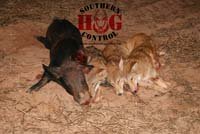Thermal Optics Used to Control Hogs and Coyotes
by Chris Monhof
Published: Southern Outdoors Magazine: December 2014
A few nights ago, I pulled into a freshly harvested peanut field about 8:45 to conduct a hog control mission for a local farmer. The field is in close proximity to a cow pasture that has had coyote problems in the past.
I picked up my 100mm thermal scope to glass the field hoping to find a sounder of 30 hogs that we had spotted two nights before. As I panned around, I saw several deer feeding in a cut corn field, about 700 yards away, and then I found it. A single boar at about 650 yards.
He was rooting from the south side of the field toward the north. I quickly secured my AR10 .308 rifle with my Armasight Zeus 3 640 75mm thermal scope mounted on top. I checked the wind, it was blowing out of the northwest at about 3 to 5 mph. I started my stalk on the west side of the field, moving to the south for about 200 yards, then to the east to get the wind in my favor.
While stalking the wild boar, I noticed that we were joined by two coyotes that also seemed to be on the stalk. I stopped for a few minutes to obser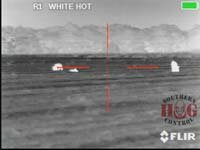 ve the coyotes, only to learn that they too were on the boar’s trail. Once they came upon the boar, they quickly changed their minds about the attack they had planned. I resumed my stalk and the coyotes moved to the north side of the hog, one laid down and the other seemed to be feeding on something about 50 yards from the boar.
ve the coyotes, only to learn that they too were on the boar’s trail. Once they came upon the boar, they quickly changed their minds about the attack they had planned. I resumed my stalk and the coyotes moved to the north side of the hog, one laid down and the other seemed to be feeding on something about 50 yards from the boar.
When I got within 90 yards of the boar, I took up a stable firing position on my tripod.
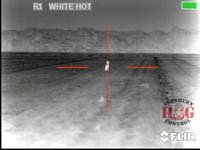 I once again observed both the boar and coyotes for a few minutes as neither knew I was there. The boar was downwind of the coyotes and knew they were there, as I watched him put his nose up and take in their scent. He then turned to move south presenting me with the perfect opportunity to introduce his right shoulder to an 180gr Hornady .308 bullet. He dropped as quickly as the hammer on my rifle. I then transitioned to the coyotes as they ran off in different directions. One headed north and the other headed northeast. The coyote that headed north stopped and offered up a perfect Texas heart shot. I took it.
I once again observed both the boar and coyotes for a few minutes as neither knew I was there. The boar was downwind of the coyotes and knew they were there, as I watched him put his nose up and take in their scent. He then turned to move south presenting me with the perfect opportunity to introduce his right shoulder to an 180gr Hornady .308 bullet. He dropped as quickly as the hammer on my rifle. I then transitioned to the coyotes as they ran off in different directions. One headed north and the other headed northeast. The coyote that headed north stopped and offered up a perfect Texas heart shot. I took it.
I went back to the truck to refit and reposition my OP (Observation Post) to the southwest side of the field. Once in my new position, I continued to scan the field to the north and east. About 45 minutes passed, when another coyote stepped out onto the peanut field, from the cotton field on the north.
The coyote was walking around as if he were looking for his buddy he had left behind earlier. I moved to about 200 yards from him and set up on the tripod again. I sent him a mouth squeak, which he responded to quickly. He approached at a galloping speed and stopped about 100 yards to my east. I took a deep breath, paused and squeezed the trigger, sending another 180gr Hornady downrange, into the awaiting coyote’s chest.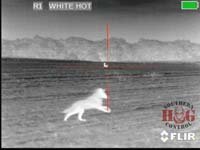
I picked up my gear and went back to the OP that I selected. Maybe 30 minutes went by, when another coyote appeared on the field. He was about 500 yards away, hovering over the boar that I had taken earlier. I quickly maneuvered into a firing position about 200 yards from the coyote. I sent him a mouth squeak, expecting the same result I had gotten from the second coyote. When out of nowhere, another coyote appeared in my scope at less than 50 yards.
This coyote was at a full sprint now, as he had closed in to find me standing in the open. I quickly transitioned targets and began tracking the newly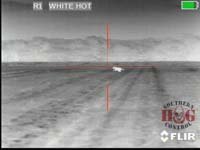 acquired coyote. I sent a round in the direction of the third coyote, missing high, the coyote turned back to the north and changed gears. I sent a second round in his direction, missing short. I increased my lead to about a full body length and sent my third round into the shoulder of the target at about 200 yards.
acquired coyote. I sent a round in the direction of the third coyote, missing high, the coyote turned back to the north and changed gears. I sent a second round in his direction, missing short. I increased my lead to about a full body length and sent my third round into the shoulder of the target at about 200 yards.
The thermal optic allowed me to perform my hog control mission and then transition to coyote control without ever changing tactics or equipment.
